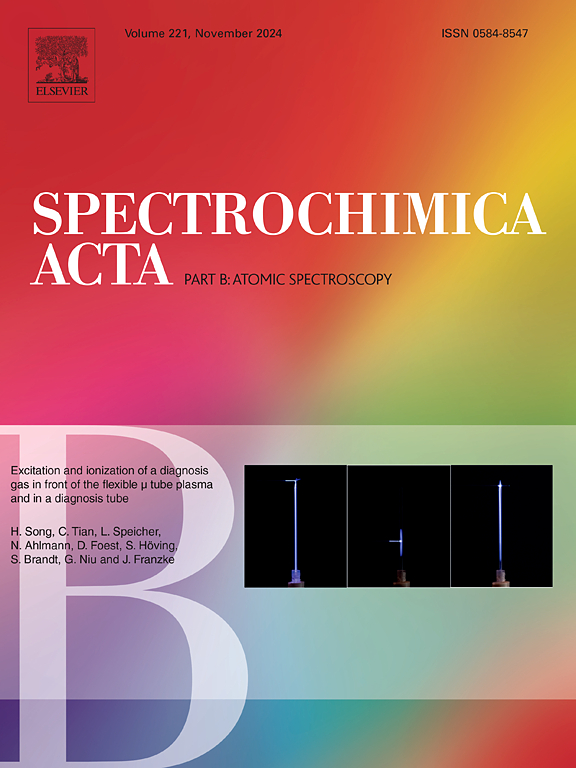双脉冲激光诱导击穿光谱技术综述
IF 3.2
2区 化学
Q1 SPECTROSCOPY
引用次数: 0
摘要
双脉冲激光诱导击穿光谱(DP-LIBS)是激光诱导击穿光谱中应用最广泛的快速元素分析方法之一。DP-LIBS是提高常规LIBS发射谱线强度和提高分析能力的有效途径。我们全面概述了DP-LIBS从基础到应用的不同方面。讨论了预烧蚀、再加热和脉冲间延迟的关键机理。概述了共线脉冲、横束脉冲、正交预烧蚀脉冲和正交再加热脉冲的不同几何结构。烧蚀激光的脉冲持续时间对烧蚀过程有很大的影响,因此,解释了激光脉冲持续时间设置的影响。这包括ns-ns、fs-fs、fs-ns和长-短DP-LIBS。研究了双脉冲LIBS对烧蚀过程和分析结果的影响,如信号强度、可重复性、烧蚀速率、火山口和等离子体尺寸以及等离子体参数。最后,介绍了从金属和合金分析、炸药检测到工业分析的几种DP-LIBS应用。DP-LIBS方法显著增强了发射强度;然而,对于有意义的应用程序,可重复性是一个需要考虑的关键参数。在不同的时间配置中,长-短DP-LIBS提供了相对平滑和更大的激光束与等离子体羽流和样品的相互作用,从而为等离子体和样品提供了更有效的时间能量传递,使其更适合于强度增强和信号改善。本文章由计算机程序翻译,如有差异,请以英文原文为准。

Double Pulse laser-induced breakdown spectroscopy (DP-LIBS): A Comprehensive technique Review
Double pulse-laser induced breakdown spectroscopy (DP-LIBS) is one of the most widely adopted variants of laser-induced breakdown spectroscopy for rapid elemental analysis. DP-LIBS is an effective way of improving the emission line intensities and increasing the analytical capabilities of conventional LIBS. We comprehensively overviewed different aspects of DP-LIBS from fundaments to applications. The key mechanisms of pre-ablation, reheating, and interpulse delay have been discussed. Different geometrical configurations for the two pulses including collinear, cross-beam, orthogonal pre-ablation, and orthogonal reheating are outlined. The pulse durations of the ablating laser have a huge impact on the ablation process, thus, the effects of the temporal settings of the laser pulse duration are explained. This includes ns-ns, fs-fs, fs-ns, and long short DP-LIBS. The impacts of double-pulse LIBS on the ablation process and analytical outcomes such as signal intensity, repeatability, ablation rate, crater and plasma size, and plasma parameters are encapsulated. Finally, several DP-LIBS applications from metal and alloy analysis and explosive detection to industrial analysis have been stipulated. DP-LIBS approach results in a notable enhancement in the emission intensity; however, repeatability is a key parameter to consider for meaningful applications. Among different temporal configurations, long-short DP-LIBS provides relatively smoother and greater interaction of the laser beam with the plasma plume and sample, hence giving a more temporally efficient energy delivery to the plasma and sample making it more suitable for intensity enhancement and signal improvement among other variants.
求助全文
通过发布文献求助,成功后即可免费获取论文全文。
去求助
来源期刊
CiteScore
6.10
自引率
12.10%
发文量
173
审稿时长
81 days
期刊介绍:
Spectrochimica Acta Part B: Atomic Spectroscopy, is intended for the rapid publication of both original work and reviews in the following fields:
Atomic Emission (AES), Atomic Absorption (AAS) and Atomic Fluorescence (AFS) spectroscopy;
Mass Spectrometry (MS) for inorganic analysis covering Spark Source (SS-MS), Inductively Coupled Plasma (ICP-MS), Glow Discharge (GD-MS), and Secondary Ion Mass Spectrometry (SIMS).
Laser induced atomic spectroscopy for inorganic analysis, including non-linear optical laser spectroscopy, covering Laser Enhanced Ionization (LEI), Laser Induced Fluorescence (LIF), Resonance Ionization Spectroscopy (RIS) and Resonance Ionization Mass Spectrometry (RIMS); Laser Induced Breakdown Spectroscopy (LIBS); Cavity Ringdown Spectroscopy (CRDS), Laser Ablation Inductively Coupled Plasma Atomic Emission Spectroscopy (LA-ICP-AES) and Laser Ablation Inductively Coupled Plasma Mass Spectrometry (LA-ICP-MS).
X-ray spectrometry, X-ray Optics and Microanalysis, including X-ray fluorescence spectrometry (XRF) and related techniques, in particular Total-reflection X-ray Fluorescence Spectrometry (TXRF), and Synchrotron Radiation-excited Total reflection XRF (SR-TXRF).
Manuscripts dealing with (i) fundamentals, (ii) methodology development, (iii)instrumentation, and (iv) applications, can be submitted for publication.

 求助内容:
求助内容: 应助结果提醒方式:
应助结果提醒方式:


